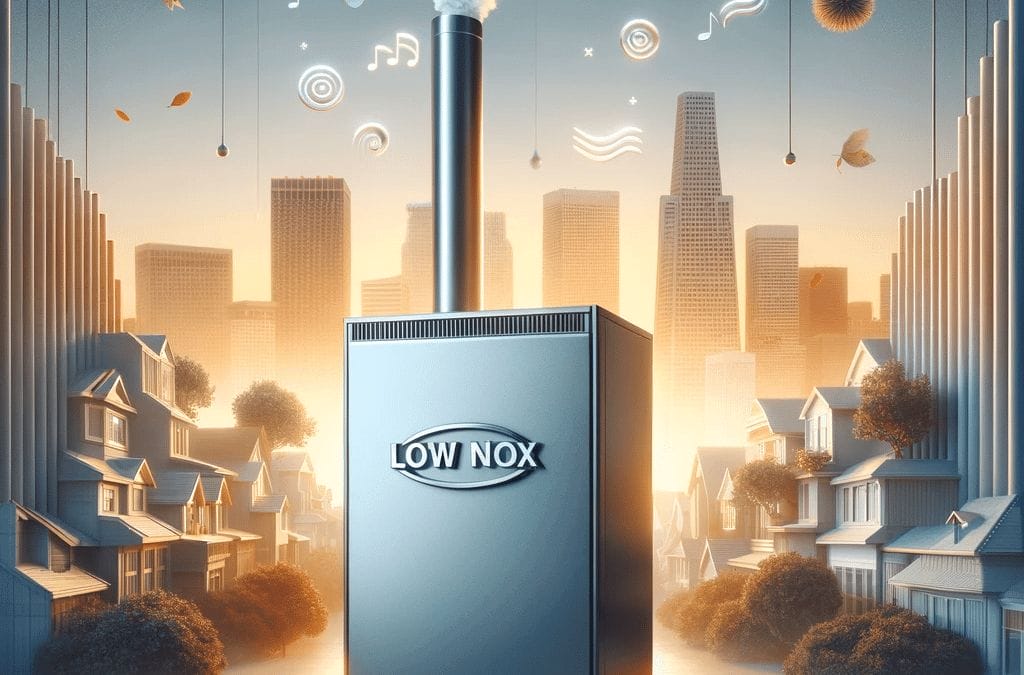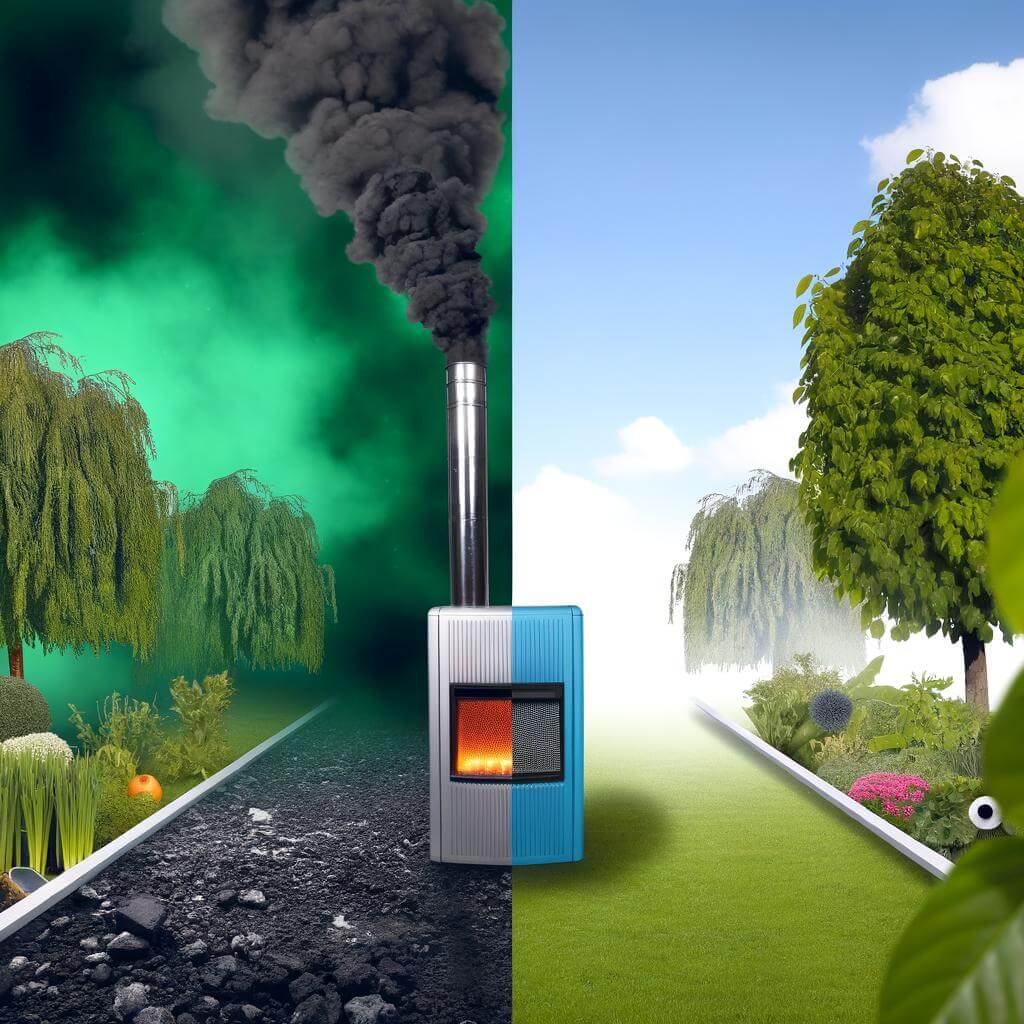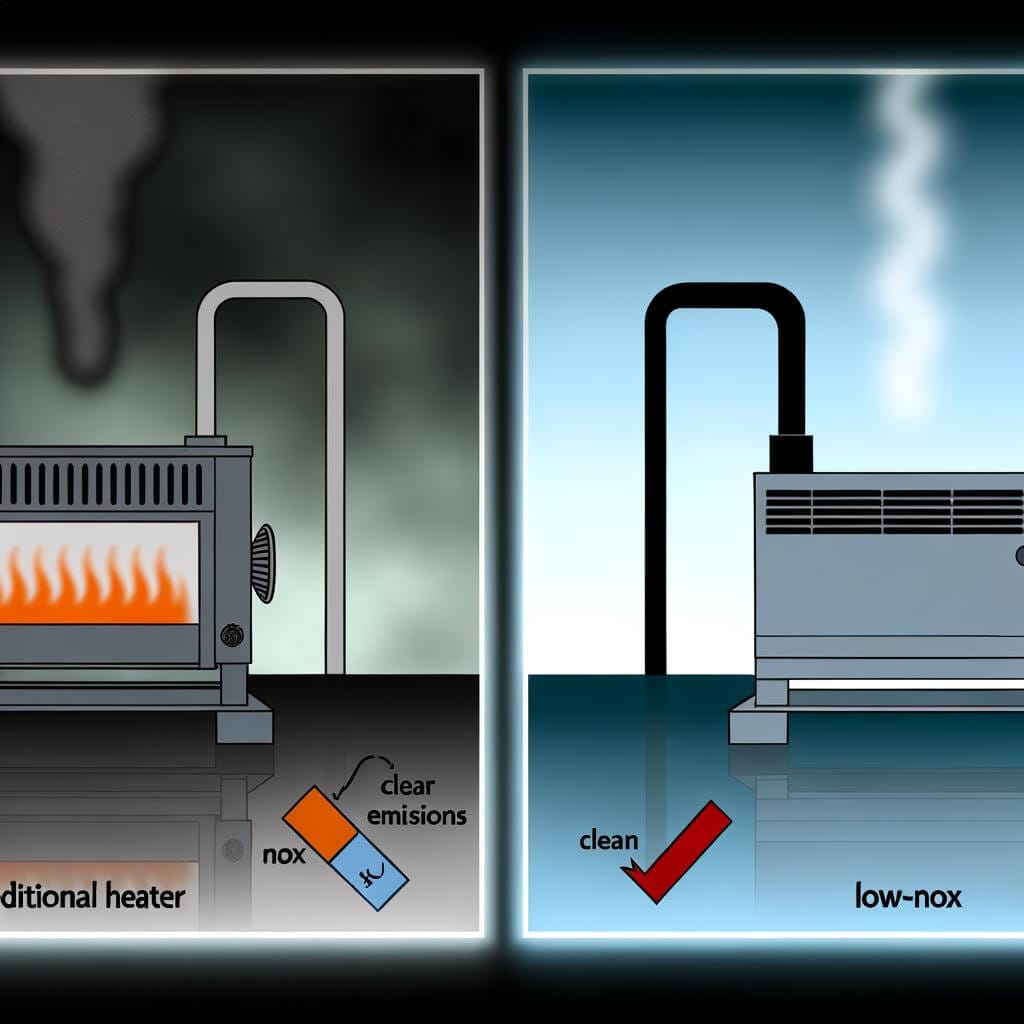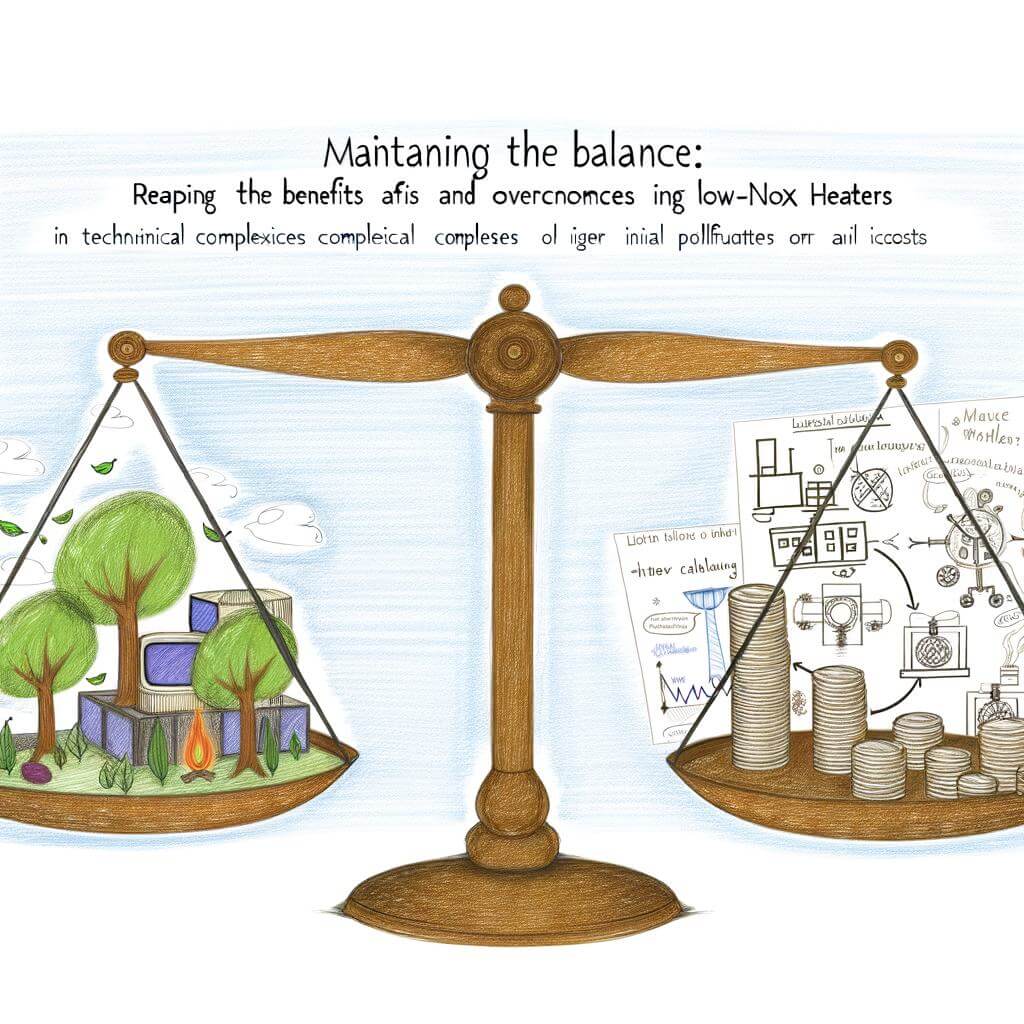
Exploring Low-NOx Heaters: California’s Requirement & Your Choice
As the sun sets on an unruly sea or a pristine beach, a chill floats through the balmy air of California. But nestled within the architectural splendor of your home, you remain blissfully unaffected, thanks to the warmth of your trusty heater. Yet as we cuddle up in comfortable spaces, it’s crucial to spare a thought for the environment that cradles us all. That’s where low-NOx heaters sway into focus, carrying the mantle of modern heating solutions that champion not just our comfort, but also our planet’s wellbeing. Imposing strict NOx emissions standards, California has started an era of more conscious heating. So, let’s journey into the intricate world of low-NOx heaters – understanding California’s mandate and your role as a responsible consumer, deciding the balance between personal comfort and global responsibility.

Understanding the Low-NOx Heating System Phenomenon
The state of California is leading the way in environmental safety standards, particularly when it comes to heating systems. A Low-NOx heating system is designed to produce fewer Nitrogen Oxides (NOx) which are harmful emissions that contribute to air pollution. These heating systems have nothing short of revolutionary impact on maintaining an environment friendly atmosphere at home, while adequately fulfilling your heating needs. It’s not often that we pay heed to the types of heaters we have at our home, considering the often overlooked fact that, the usual heating systems emit a noticeably high degree of NOx, jeopardizing the environment’s health. In order to encourage the use of Low-NOx heaters, the California state authorities have implemented stringent rules requiring new heating system installations to be Low-NOx compliant. Existing heaters need not be immediately replaced but when the time comes for replacement or if a new heater is needed, Low-NOx type must be considered. There are numerous benefits to using these types of heaters, which include:
- Lower environmental impact: Low-NOx heaters produce less pollution, contributing to better air quality.
- High efficiency: These heating systems provide a high level of heat output while using less energy, thereby conserving resources.
- Cost-saving: Due to their efficient nature, Low-NOx systems can provide significant savings on heating costs over time.
| Types of Low-NOx Heaters | Expected Lifespan | Average Cost |
|---|---|---|
| Gas Pool Heaters | 5-10 years | $1,500-$3,000 |
| Furnace | 15-20 years | $2,500-$5,000 |
| Boiler | 15-20 years | $3,500-$7,500 |
Though some might argue the initial cost of Low-NOx heaters is steep, it’s essential to consider the long-term benefits in terms of savings on energy bills and upkeep of environmental health.

Delving Deeper: Why California Requires Low-NOx Heaters
When it comes to heating your home in California, regulations require the use of low nitrogen oxide (Low-NOx) heaters. This isn’t a random recommendation, rather, a well-founded requirement aimed at preserving the environment and maintaining good air quality. Low-NOx heaters reduce the amount of nitrogen oxide (a harmful substance) released into the atmosphere, thus significantly decreasing levels of pollution.
Your choice of heaters could significantly contribute to fighting air pollution. Benefits of opting for Low-NOx heaters include:
- Lower Emissions: As the name suggests, Low-NOx heaters emit less nitrogen oxide into the atmosphere, potentially reducing the formation of smog and acid rain.
- Improved Air Quality: Lower emissions, in turn, promote better air quality. This not only benefits the environment, but can also help mitigate health issues that arise from air pollution.
- Energy Efficiency: These heaters often deliver better energy efficiency compared to regular models, aiding in reducing power bills.
Choosing the right Low-NOx heater can be challenging, especially with the numerous makes and models in today’s market. For a quick overview, here’s a comparison of some top low-NOx heater models to consider:
| Model | Efficiency Rating | Warranty Period |
|---|---|---|
| XYZ Low-NOx Heater | 95% | 5 Years |
| ABC Eco-friendly Heater | 92% | 3 Years |
| DEF Low-Emission Heater | 96% | 7 Years |
Investing in a Low-NOx heater isn’t just about compliance with state regulations—it’s about making a proactive choice for the betterment of the environment and our health. Embrace Low-NOx heaters for a cleaner and greener future.

Decoding the Environmental Impact of Low-NOx Heaters
With environmental consciousness on the rise, it’s no surprise that there has been a considerable shift towards more eco-friendly heating solutions, with Low-NOx heaters leading the charge. These heaters have come into prominence for their ability to minimize Nitrogen Oxide (NOx) emissions, a crucial factor in curbing global warming. Particularly in California, laws have now mandated the use of Low-NOx heaters, spotlighting their environmental and health benefits. Understanding Low-NOx Heaters Low-NOx heaters are specially designed to emit a lower quantity of nitrogen oxides, which are potent greenhouse gases. They accomplish this through unique design elements such as specialized burners and advanced combustion systems. Starting January 1, 2020, the South Coast Air Quality Management District (SCAQMD) in California mandated the installation and sale of Ultra-Low NOx water heaters. This requirement affected over 10 million residents in the region, sparking a widespread switch to the more eco-friendly heating alternatives. The following table gives a brief comparison of Standard NOx and Low-NOx heaters.
| Type of Heater | NOx Emissions | Environmental Impact |
|---|---|---|
| Standard NOx | 55 to 65 nanograms per joule | Higher NOx emissions contribute more to air pollution |
| Low-NOx | <20 nanograms per joule | Lower NOx emissions reduce environmental footprint |
How Do Low-NOx Heaters Impact the Environment? Lower Nitrogen Oxide emissions mean less contribution to the formation of smog and acid rain, providing significant ecological advantages. Moreover, they play a pivotal role in reducing the likelihood of respiratory complications linked to the inhalation of NOx gases.
- Reduction in Air Pollution: Low-NOx heaters release minimal quantities of NOx gases into the environment, subsequently lowering the incidence of smog and acid rain.
- Fewer Health Hazards: Minimized NOx emissions lead to a decrease in respiratory ailments in humans, thus reducing health-related concerns.
- Energy Efficiency: While being eco-friendly, Low-NOx heaters also provide improved energy efficiency, thus making them a smart choice economically as well.
Given the clear advantages they offer, Low-NOx heaters are not just a legal requirement but an environmentally sensible choice for homeowners in California and around the world.

Bringing the Heat: Comparing Traditional to Low-NOx Heaters
California’s push for environmental conservation has led to stringent restrictions on a range of gas products. Herbivores, for example, have adopted Low-NOx (low nitrogen oxide) standards that require all new gas heaters to produce fewer ground-level ozone pollutants. This shift in regulatory standards has invariably brought a new consideration for consumers searching for a heating solution — traditional versus low-NOx heaters. But how does one really compare the two? Let’s delve into the matter.
The Traditional Heater:
These have long served as reliable, efficient options for heating up homes. They convert a higher percentage of their fuel into usable heat. The key benefits of these heaters include:
- High heat output
- Less costly upfront
- Easy to find in the market
However, they produce more nitrogen oxide, a hazardous air pollutant. This makes them less eco-friendly and can result in penalties in areas with stricter environmental regulations.
The Low-NOx Heater:
Low-NOx heaters are designed to restrict the release of nitrogen oxide. The result? Less pollution and more breathing room for the environment. Yet, they do come with their pros and cons.
| Pros | Cons |
|---|---|
| Eco-friendly | Costly upfront |
| Complies with regulatory standards | Requires specialized servicing |
In California, especially, adherence to these environmental standards is crucial. Therefore, favoring low-NOx heaters over traditional ones often becomes a no-brainer.
While the choice between the two can seem daunting, the key lies in understanding the specific requirements and context. Regulations, budget, efficiency expectations, and environmental consciousness all come into play when making this important decision.

Your Turn: Selecting the Best Low-NOx Heater for Your Home
Now it’s your turn to decide which is the best Low-NOx heater for your home. Firstly, collect the complete details about your home’s heating requirements. This includes size of your home, the average temperature in your area, your budget and your preference for type of fuel such as gas or electric. Next, list down potential Low-NOx heaters that meet these requirements. It’s advisable to read through customer reviews and ratings and also consult with a professional HVAC service provider to get a thorough understanding of their potential performance and longevity.
Once you have your selected choices, you can start the process of comparison. Here are a few parameters that can guide you in your decision:
- Energy Efficiency: An energy efficient heater will consume less fuel, thus reducing your heating costs effectively.
- Size of Heater: A heater smaller or larger than the recommended size for your home will cause temperature fluctuations and energy inefficiency.
- Heater’s Lifespan: Although Low-NOx heaters tend to have long lifetimes, each brand and model may differ.
- Warranty: Always check the warranty period offered for the heater as it can protect your investment for a good number of years.
You might list down the options in a table format for easier comparison, similar to this:
| Heater Model | Energy Efficiency | Size | Lifespan | Warranty |
|---|---|---|---|---|
| Model A | 95% | Medium Size | 20 Years | 5 years |
| Model B | 98% | Large Size | 15 Years | 7 years |
Take your time in making the decision as the right Low-NOx heater can bring significant improvements to your home’s comfort and air quality while greatly reducing your heating costs and environmental impact.

Maintaining the Balance: Reaping the Benefits and Overcoming Challenges in Using Low-NOx Heaters
Low-NOx heaters have become an integral part of many Californian homes and businesses in response to stringent emissions regulations. Known for their reduced nitrogen oxide (NOx) output, these heaters offer a cleaner means of warming up spaces while minimizing environmental harm. As a user, it’s important to harness the benefits these heaters offer and navigate possible challenges to ensure a cost-effective and environmentally friendly heating solution. Benefits of Low-NOx Heaters
Low-NOx heaters come with several advantages. Firstly, they minimize environmental impact by reducing NOx emissions, which are known to contribute to smog, acid rain, and deterioration of the ozone layer. Secondly, they are more energy efficient than conventional heaters, translating to lower energy costs. Lastly, due to California’s lowered emission mandations, adhering to these regulations can prevent potential violations and associated fines. Challenges in Using Low-NOx Heaters Deployment of these heaters does pose certain challenges that users need to address. The initial cost of purchase and installation is higher than regular heaters. Plus, they require regular maintenance to ensure they continue functioning optimally and complying with emission standards. Additionally, understanding and keeping up with the continually changing local and state emission regulations can be a daunting task for homeowners and businesses. Here’s a quick comparison of low-NOx heaters with conventional ones:
Heater Type Initial cost Maintenance required Environmental impact Low-NOx Heater High Medium Low Conventional Heater Low Low High
In essence, while the use of Low-NOx heaters complies with California’s stringent emission regulations, acknowledging and preparing for the associated challenges enables you to capitalize on their benefits. In conclusion, the journey through the whirlwind realm of Low-NOx heaters has been edifying. It illustrates not only California’s unwavering commitment to implement eco-friendly technology but also the choice lying in our palms to contribute to a cleaner, greener environment- one Low-NOx heater at a time. Like a drop of water that sends ripples reverberating through a serene pond, every decision we take generates change in our environment, rippling out towards a broader range. As we close this chapter on Low-NOx heaters, remember, the power to shape the future is but a thermostat-click away. Where innovation meets necessity, moments of choice are arrayed before us. And in those moments, we hold the power to turn up the heat on environmental conservation.







